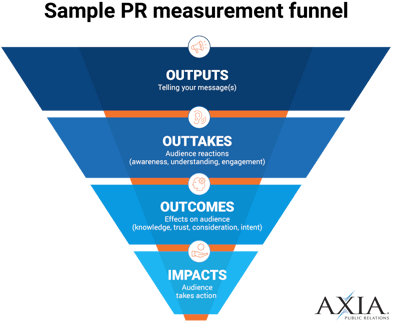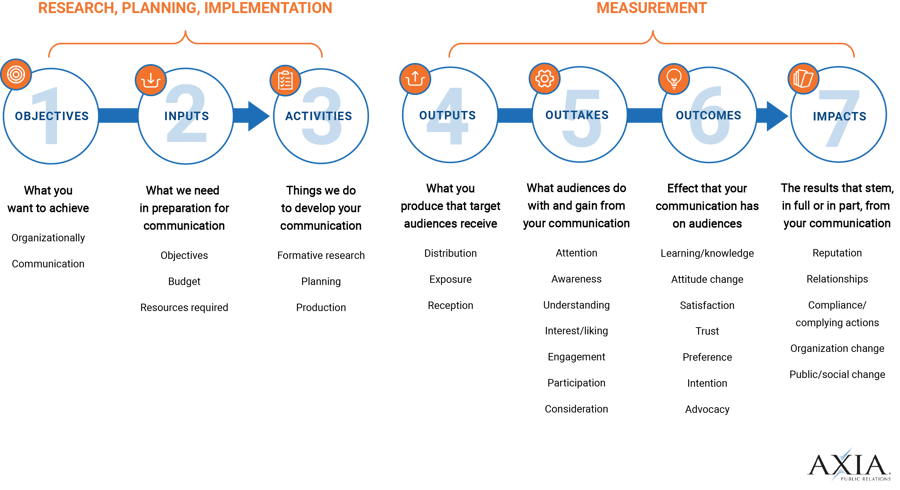Yes, PR is measurable. How to measure and report public relations and strategic corporate communications
By Jason MuddNovember 10, 2020
Use our step-by-step guide for measuring public relations the right way.
 Before you can meaningfully explore PR measurement, you have to account for research, planning, and implementation. Research and planning will help you identify the end results, and then you can work backward from the desired results.
Before you can meaningfully explore PR measurement, you have to account for research, planning, and implementation. Research and planning will help you identify the end results, and then you can work backward from the desired results.
Too often, executives and public relations pros want to measure PR without establishing a research baseline.
Under research, planning, and implementation, you have objectives, inputs, and activities. And under measurement, you have outputs, outtakes, outcomes, and impacts. Although most public relations professionals at PR firms and in-house PR staff tend to focus on measuring activities and outputs, efficient and effective measurement goes well beyond measuring activities and outputs.
Let’s start at the beginning. A good framework for measuring public relations and corporate communications begins with objectives.
1. Objectives
Objectives are what you want to achieve. Start with organizational or company objectives and make sure your strategic corporate communications and public relations objectives are in full alignment with your organizational objectives.
You want to work in tandem with what the company is trying to accomplish. You want what you’re focused on to be in full alignment with and consistently focused on what the company’s leadership is also focusing on. It wouldn’t make sense for strategic communications to have a different objective from what objectives the company is currently focusing on.
All corporate communications should strategically align with the company’s overall organizational objectives. While you’re at it, make sure you’re focused on and measuring with SMARTER objectives.
2. Inputs

Inputs are what you need in preparation for communication implementation. Taking your SMARTER objectives and resource requirements into consideration, you will be better able to determine the budget you’ll need.
Begin by defining your target audience(s). You want to be as specific as possible, thinking about demographics like age range, sex, income level, and geolocation. Demographics help you determine where and how your audience consumes media and information.
Next, you want to figure out what resources you have and what you may need to implement your strategy. Here are a few examples:
-
Staff to create dynamic, compelling content (internally or through your PR agency)
-
Online influencers and user-generated content — and a system to manage it all
-
Which social platforms or networks you will use (based on your target audience) and someone to manage them
-
Custom website or landing pages with additional information
-
Creative and graphic design
-
Media relations specialist to pitch appropriate media outlets
-
Potential partnerships or co-branding opportunities
Inputs are crucial because they provide focus for your strategic plan. Inputs help you determine the scope and budget for implementing that plan. You must document and agree on these input points before moving on to the next step.
If you find you don’t have the internal resources, companies and organizations often find it’s less expensive to hire an agency rather than recruiting and bringing on in-house staff.
3. Activities
Activities are what you do to plan and produce your communication. These are the tactics people typically think of when they think of PR: formative research, online content creation and social media posts, video production, news releases, and influencer and journalist relationship-building. Activities also guide you in creating a measurement plan and the methodology that will be used to measure your results.
Formative research is a critical component. First, consider any existing research data you may have to determine whether it’s pertinent and usable. If the research you have is no longer relevant (or there isn’t any at all), then decide what research you or your agency needs to do to garner the insights and intelligence you need to set benchmarks. These are the baselines you’ll use to measure against.
Whether the activities are about researching to establish baselines and benchmarks, strategic planning, evaluation planning, or content-related information, all communication activities must support the organization’s overall organization or company objectives.
4. Outputs
Outputs are what you produce that your target audiences receive. Outputs take your SMARTER objectives, strategic plan, and tactical (activities) plan and put them to work through dissemination, exposure, and reception. Outputs communicate your message through earned, shared, and owned media.
Distributing news releases, pitching the media, email marketing distribution, hosting an event, proactive communication through social (shared) and owned media channels, and regular activity reporting are all examples of outputs.
Outputs are essentially anything you or your agency do to get your message in front of the right audiences. Evaluating outputs like news release distribution and social media messages can happen organically or through media monitoring tools. Outputs are essential to the overall PR strategy. Regular reporting and evaluation of outputs allow your PR team or agency to see what is and is not working so you can modify and improve your future outputs.
5. Outtakes
Outtakes are what your audiences take out of your communication — how they react to it. Outtakes are the result of evaluating and measuring you or your agency’s outputs. Outtakes help you understand your outputs’ perception and whether your outputs had any influence on your target audiences.
Outtakes go beyond disseminating messages; they ascertain whether target audiences received, paid attention to, comprehended, and retained the messages communicated to them. Examples of outtakes include attention, awareness, understanding, interest level, engagement, participation, and consideration.
How your audience reacts to your outputs is an integral part of the PR measurement process. It helps you determine whether your outputs are on track to affect the changes identified in the planning (inputs and activities). Outtakes provide the basic information you need to measure outcomes.
6. Outcomes
Outcomes are the effects your communication has on your target audiences that align with the overall company or organization objectives. These are a result of your activities and outputs. Outcomes measure what people do (i.e., what action they take) as a result of your communication.
Outcomes may include the following:
-
Improvement of attitudes (sentiment) and satisfaction
-
Build trust and loyalty
-
Create an uptick of unique visitors to your site
-
Increase page views or downloads
-
Raise click-through-rates (CTR)
-
Increase and expand email or newsletter subscriptions
-
Attend your webinar or event
-
Watch your video or listen to your podcast
-
Contribute to advocacy or activism
-
Create positive community engagement
-
Increase positive sharing and commenting (by reducing negative comments)
Outcomes provide real business insights. Steer clear of vanity metrics like advertising value equivalency (AVE) or impressions. Axia Public Relations does not report AVEs because they are superficial and provide no real evidence of communication effects.
7. Impacts
Impacts reflect the results that stem from your communication. They demonstrate how your communication contributed to overall business objectives. Impacts allow your team or agency to show PR value in terms of return on investment (ROI) and how the activities and outputs drive real business outcomes.
PR impacts may include company reputation, revenue, compliance (or complying actions), relationships, recruiting, or organizational or public/social change. Examples of impacts are public support, meeting targets, improvement in the quality of sales leads, cost savings, staff retention, customer loyalty, and reduced customer churn.
Analysis should provide realistic context to what role communication plays in your organization. A key component of determining and reporting impacts is the deployment of qualitative research, not just quantitative.
For maximum effect, you should view outputs, outtakes and outcomes as links in a chain. One leads to the next, and together they help deliver the desired impact.
Axia’s seven principles of measuring public relations align with the International Association of the Measurement and Evaluation of Communication (AMEC) Barcelona Principles.
See also What are the Barcelona Principles of PR Measurement and Why Should I Care?
To learn more about our measurement practices, you can view Axia’s PR measurement webinar or download our Measurement Matters e-book. Contact us to find out how we can produce outputs that provide measurable audience outcomes for your brand.
Topics: public relations, corporate communications, measurement, Staff Recommendations



Comment on This Article